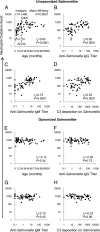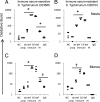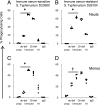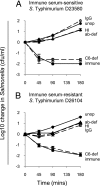Importance of antibody and complement for oxidative burst and killing of invasive nontyphoidal Salmonella by blood cells in Africans
- PMID: 20133627
- PMCID: PMC2840319
- DOI: 10.1073/pnas.0910497107
Importance of antibody and complement for oxidative burst and killing of invasive nontyphoidal Salmonella by blood cells in Africans
Abstract
Bacteremia caused by nontyphoidal strains of Salmonella is endemic among African children. Case-fatality rates are high and antibiotic resistance increasing, but no vaccine is currently available. T cells are important for clearance of Salmonella infection within macrophages, but in Africa, invasive Salmonella disease usually manifests in the blood and affects children between 4 months and 2 y of age, when anti-Salmonella antibody is absent. We have previously found a role for complement-fixing bactericidal antibody in protecting these children. Here we show that opsonic activity of antibody and complement is required for oxidative burst and killing of Salmonella by blood cells in Africans. Induction of neutrophil oxidative burst correlated with anti-Salmonella IgG and IgM titers and C3 deposition on bacteria and was significantly lower in African children younger than 2 y compared with older children. Preopsonizing Salmonella with immune serum overcame this deficit, indicating a requirement for antibody and/or complement. Using different opsonization procedures, both antibody and complement were found to be necessary for optimal oxidative burst, phagocytosis and killing of nontyphoidal Salmonella by peripheral blood cells in Africans. Although most strains of African nontyphoidal Salmonella can be killed with antibody and complement alone, phagocytes in the presence of specific antibody and complement can kill strains resistant to killing by immune serum. These findings increase the likelihood that an antibody-inducing vaccine will protect against invasive nontyphoidal Salmonella disease in African children.
Conflict of interest statement
The authors declare no conflict of interest.
Figures




Similar articles
-
Absent bactericidal activity of mouse serum against invasive African nontyphoidal Salmonella results from impaired complement function but not a lack of antibody.J Immunol. 2011 Feb 15;186(4):2365-71. doi: 10.4049/jimmunol.1000284. Epub 2011 Jan 7. J Immunol. 2011. PMID: 21217014
-
Invasive African nontyphoidal Salmonella requires high levels of complement for cell-free antibody-dependent killing.J Immunol Methods. 2013 Jan 31;387(1-2):121-9. doi: 10.1016/j.jim.2012.10.005. Epub 2012 Oct 22. J Immunol Methods. 2013. PMID: 23085530
-
Bactericidal Immunity to Salmonella in Africans and Mechanisms Causing Its Failure in HIV Infection.PLoS Negl Trop Dis. 2016 Apr 8;10(4):e0004604. doi: 10.1371/journal.pntd.0004604. eCollection 2016 Apr. PLoS Negl Trop Dis. 2016. PMID: 27057743 Free PMC article.
-
Contradictory roles for antibody and complement in the interaction of Brucella abortus with its host.Crit Rev Microbiol. 1995;21(3):153-63. doi: 10.3109/10408419509113538. Crit Rev Microbiol. 1995. PMID: 8845060 Review.
-
Invasive Nontyphoidal Salmonella Disease in Africa.EcoSal Plus. 2019 Jan;8(2):10.1128/ecosalplus.ESP-0007-2018. doi: 10.1128/ecosalplus.ESP-0007-2018. EcoSal Plus. 2019. PMID: 30657108 Free PMC article. Review.
Cited by
-
Probiotic Bacteria and Their Cell Walls Induce Th1-Type Immunity Against Salmonella Typhimurium Challenge.Front Immunol. 2021 May 12;12:660854. doi: 10.3389/fimmu.2021.660854. eCollection 2021. Front Immunol. 2021. PMID: 34054825 Free PMC article.
-
Outer membrane protein X (Ail) contributes to Yersinia pestis virulence in pneumonic plague and its activity is dependent on the lipopolysaccharide core length.Infect Immun. 2010 Dec;78(12):5233-43. doi: 10.1128/IAI.00783-10. Epub 2010 Sep 13. Infect Immun. 2010. PMID: 20837715 Free PMC article.
-
Immunity to intestinal pathogens: lessons learned from Salmonella.Immunol Rev. 2014 Jul;260(1):168-82. doi: 10.1111/imr.12184. Immunol Rev. 2014. PMID: 24942689 Free PMC article. Review.
-
Presentation of life-threatening invasive nontyphoidal Salmonella disease in Malawian children: A prospective observational study.PLoS Negl Trop Dis. 2017 Dec 7;11(12):e0006027. doi: 10.1371/journal.pntd.0006027. eCollection 2017 Dec. PLoS Negl Trop Dis. 2017. PMID: 29216183 Free PMC article.
-
Quantification of the effects of antibodies on the extra- and intracellular dynamics of Salmonella enterica.J R Soc Interface. 2012 Dec 12;10(79):20120866. doi: 10.1098/rsif.2012.0866. Print 2013 Feb. J R Soc Interface. 2012. PMID: 23235264 Free PMC article.
References
-
- Gordon MA, et al. Epidemics of invasive Salmonella enterica serovar Enteritidis and S. enterica Serovar Typhimurium infection associated with multidrug resistance among adults and children in Malawi. Clin Infect Dis. 2008;46:963–969. - PubMed
-
- Berkley JA, et al. Bacteremia among children admitted to a rural hospital in Kenya. N Engl J Med. 2005;352:39–47. - PubMed
-
- Graham SM, et al. Nontyphoidal Salmonella infections of children in tropical Africa. Pediatr Infect Dis J. 2000;19:1189–1196. - PubMed
-
- Molyneux EM, et al. The outcome of non-typhoidal salmonella meningitis in Malawian children, 1997-2006. Ann Trop Paediatr. 2009;29:13–22. - PubMed
Publication types
MeSH terms
Substances
Grants and funding
LinkOut - more resources
Full Text Sources
Medical
Miscellaneous

